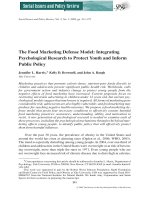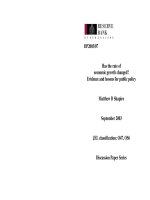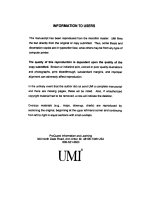Public finance and public policy
Bạn đang xem bản rút gọn của tài liệu. Xem và tải ngay bản đầy đủ của tài liệu tại đây (3.51 MB, 210 trang )
Public Finance and Public Policy Jonathan
CopyrightGruber
© 2012 Fourth
Worth Edition
Publishers
Copyright © 2012 Worth Publishers
1
INTRODUCTION TO PUBLIC FINANCE?
1
1.1 The Four Questions of Public Finance
1.2 Why Study Public Finance? Facts on Government in
the United States and Around the World
1.3 Why Study Public Finance Now? Policy Debates over
Social Security, Health Care, and Education
1.4 Conclusion
Public Finance and Public Policy Jonathan Gruber Fourth Edition Copyright © 2012 Worth Publishers
2
1.1
The Four Questions of Public Finance
• Public finance: The study of the role of the government
in the economy.
Four questions of public finance:
1. When should the government intervene in the
economy?
2. How might the government intervene?
3. What is the effect of those interventions on economic
outcomes?
4. Why do governments choose to intervene in the way
that they do?
Public Finance and Public Policy Jonathan Gruber Fourth Edition Copyright © 2012 Worth Publishers
3
1.1
When Should the Government Intervene in the
Economy?
• Economics generally presumes that markets deliver
efficient outcomes, so why should government do
anything?
P
S = (MC)
$14
$12
$10
$8
$6
D = (MB)
90
100
110
Q
Public Finance and Public Policy Jonathan Gruber Fourth Edition Copyright © 2012 Worth Publishers
4
1.1
When Should the Government Intervene in the
Economy?
• Primary motive for government intervention is
therefore market failure and redistribution.
Market failure Problem
that causes the market
economy to deliver an
outcome that does not
maximize efficiency.
Public Finance and Public Policy Jonathan Gruber Fourth Edition Copyright © 2012 Worth Publishers
5
Problems for the Free Market
Externalities: Chapter 3
Figure 1.8
Negative
externality
MSC = (MC + marginal
environmental damage)
Solution?
A corrective tax.
P
MSC
B
$14 –
$12 –
D
$10 –
S (MC)
$4
A
$8 –
D (MB)
$6 –
90
100
110
Q
Public Finance and Public Policy Jonathan Gruber Fourth Edition Copyright © 2012 Worth Publishers
6
Problems for the Free Market
Externalities: Chapter 3
Figure 1.9
Positive
externality
MSB = (MC + marginal
benefit to other people)
Solution?
A corrective subsidy.
P
B
$14 –
D
$4
$12 –
$10 –
S (MC)
MSB
A
$8 –
D (MB)
$6 –
90
100
110
Q
Public Finance and Public Policy Jonathan Gruber Fourth Edition Copyright © 2012 Worth Publishers
7
1.1
APPLICATION: The Measles Epidemic of 1989−1991
• Measles vaccine introduced in 1963, and measles
cases had become relatively rare in the United States
by the 1980s.
• 1989−1991: Huge resurgence in measles.
• This outbreak resulted from very low immunization
rates among disadvantaged inner-city youths.
• Unimmunized children imposed a negative externality
on other children.
Public Finance and Public Policy Jonathan Gruber Fourth Edition Copyright © 2012 Worth Publishers
8
1.1
APPLICATION: The Measles Epidemic of 1989−1991
• The federal government responded to this health crisis
in the early 1990s:
o Encouraged parents to immunize their children.
o Paid for the vaccines for low-income families.
• Impressive results:
• Immunization rates never higher than 70% prior to
outbreak.
• Rose to 90% by 1995.
• Government intervention clearly reduced this negative
externality.
Public Finance and Public Policy Jonathan Gruber Fourth Edition Copyright © 2012 Worth Publishers
9
Problems for the Free Market
Public Goods: Chapter 4
• A public good has 2 properties:
1. Non-rivalry
2. Non-excludability
• Free-rider problem
Income distribution, taxation and efficiency: Chapter 6
• Income redistribution
• Taxation – progressive, regressive,
and proportional
• Efficiency trade-offs
Public Finance and Public Policy Jonathan Gruber Fourth Edition Copyright © 2012 Worth Publishers
10
1.1
When Should the Government Intervene in the
Economy?
• Even if the market is well-functioning, an efficient
outcome is not necessarily socially desirable.
• Redistribution is a second reason for government
intervention.
Redistribution The
shifting of resources from
some groups in society to
others.
Public Finance and Public Policy Jonathan Gruber Fourth Edition Copyright © 2012 Worth Publishers
11
1.1
How Might Governments Intervene?
• Tax or Subsidize Private Sale or Purchase
o Use the price mechanism, changing the price of a
good to encourage or discourage use.
• Taxes raise the price for private sales or purchases of
goods that are overproduced.
• Subsidies lower the price for private sales or purchases
of goods that are under-produced.
Public Finance and Public Policy Jonathan Gruber Fourth Edition Copyright © 2012 Worth Publishers
12
Taxes
A tax levied on
producers
P
P
S`
$14
S
T=$4
$12
$10
or a tax levied on consumer
$14
S
$12
$10
T=$4
T=$4
$8
$8
D
$6
90
100
110
Q
T=$4
D
$6
90
100
110
D`
Q
…produces the same effect.
A decrease in quantity.
Public Finance and Public Policy Jonathan Gruber Fourth Edition Copyright © 2012 Worth Publishers
13
Subsidies
A subsidy given to producers or a subsidy given to consumers
P
P
S
$14
$12
$12
S=$4
$10
$8
$14
S`
S=$4
$10
S=$4
D`
$8
S=$4
D
$6
90
S
100
110
Q
D
$6
90
100
110
Q
…produces the same effect:
an increase in quantity
Public Finance and Public Policy Jonathan Gruber Fourth Edition Copyright © 2012 Worth Publishers
14
1.1
How Might Governments Intervene?
• Restrict or Mandate Private Sale or Purchase
o Quotas restrict private sale of goods that are
overproduced.
o Mandates require private purchase of goods that
are under-produced.
• Public Provision
o The government can provide the good directly.
• Public Financing of Private Provision
o Governments pays, private companies produce.
Public Finance and Public Policy Jonathan Gruber Fourth Edition Copyright © 2012 Worth Publishers
15
1.1
What Are the Effects of Alternative Interventions?
Interventions have direct and indirect effects.
• Direct effects: The effects that would be predicted if
individuals did not change their behavior in response
to the interventions.
o With 49 million uninsured, providing universal
health insurance covers 49 million people.
• Indirect effects: The effects that arise only because
individuals change their behavior in response to the
interventions.
o If people drop private coverage, many more people
may end up covered by the public plan.
Public Finance and Public Policy Jonathan Gruber Fourth Edition Copyright © 2012 Worth Publishers
16
1.1
Why Do Governments Do What They Do?
• Governments do not always choose efficient or socially
desirable outcomes.
• Political economy: The theory of how the political
process produces decisions that affect individuals and
the economy.
Public Finance and Public Policy Jonathan Gruber Fourth Edition Copyright © 2012 Worth Publishers
17
1.2
Why Study Public Finance?
The government is a huge part of the economy:
• Government spending represents a large sector of the
economy, in the United States and around the world.
• This spending is financed with taxes or with debt, and
these affect every facet of the economy.
• Many sectors of the economy are also directly affected
by regulation.
Public Finance and Public Policy Jonathan Gruber Fourth Edition Copyright © 2012 Worth Publishers
18
1.1
APPLICATION: The Congressional Budget Office as
Gatekeepers
• The methods and results derived from empirical
economics are central to the development of public
policy at all levels of government.
• The Congressional Budget Office (CBO) “scores” policy
proposals by estimating their budget implications.
• CBO scoring uses the theoretical and empirical tools of
public finance.
• CBO scores can determine the fate of legislation.
Public Finance and Public Policy Jonathan Gruber Fourth Edition Copyright © 2012 Worth Publishers
19
1.2
Federal Spending as a Percent of GDP, 1930−2011
Public Finance and Public Policy Jonathan Gruber Fourth Edition Copyright © 2012 Worth Publishers
20
1.2
Total Government Spending Across Developed
Nations, 1960−2013
Public Finance and Public Policy Jonathan Gruber Fourth Edition Copyright © 2012 Worth Publishers
21
1.2
Federal Revenues and Expenditures, 1930−2011
Public Finance and Public Policy Jonathan Gruber Fourth Edition Copyright © 2012 Worth Publishers
22
1.2
Federal Surplus/Deficit, 1930−2011
Public Finance and Public Policy Jonathan Gruber Fourth Edition Copyright © 2012 Worth Publishers
23
1.2
Federal Debt, 1930−2011
Public Finance and Public Policy Jonathan Gruber Fourth Edition Copyright © 2012 Worth Publishers
24
1.2
Debt Level of OECD Nations in 2011
Public Finance and Public Policy Jonathan Gruber Fourth Edition Copyright © 2012 Worth Publishers
25









